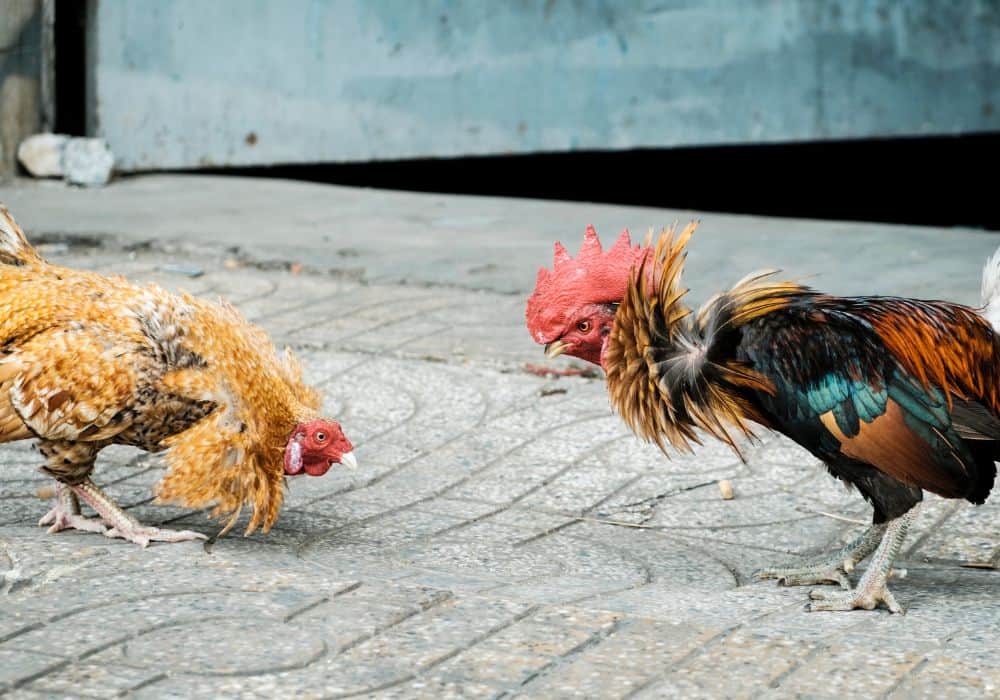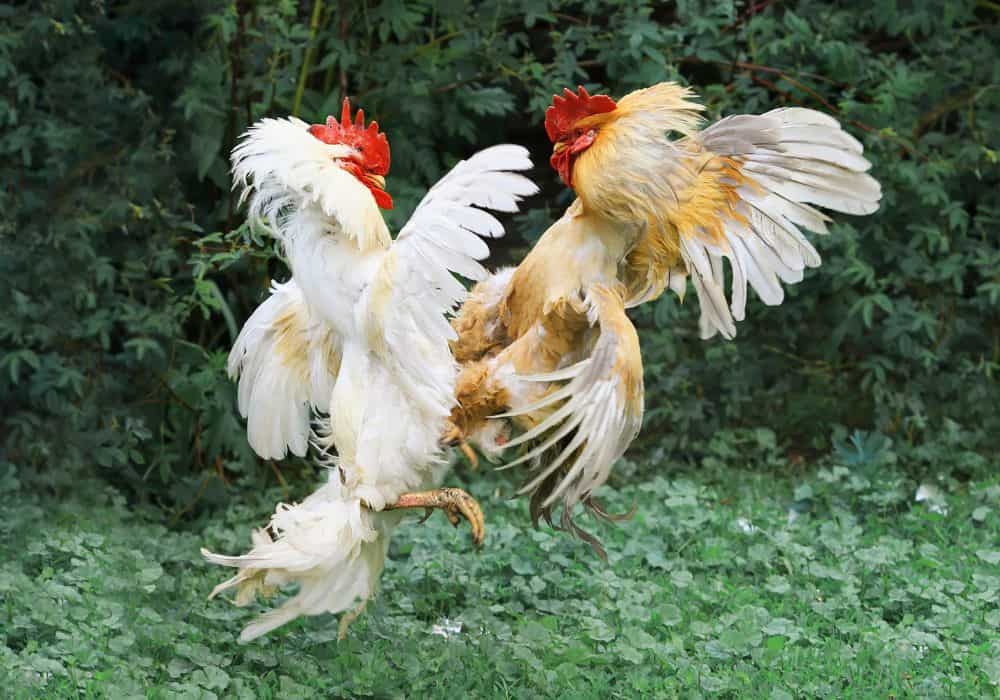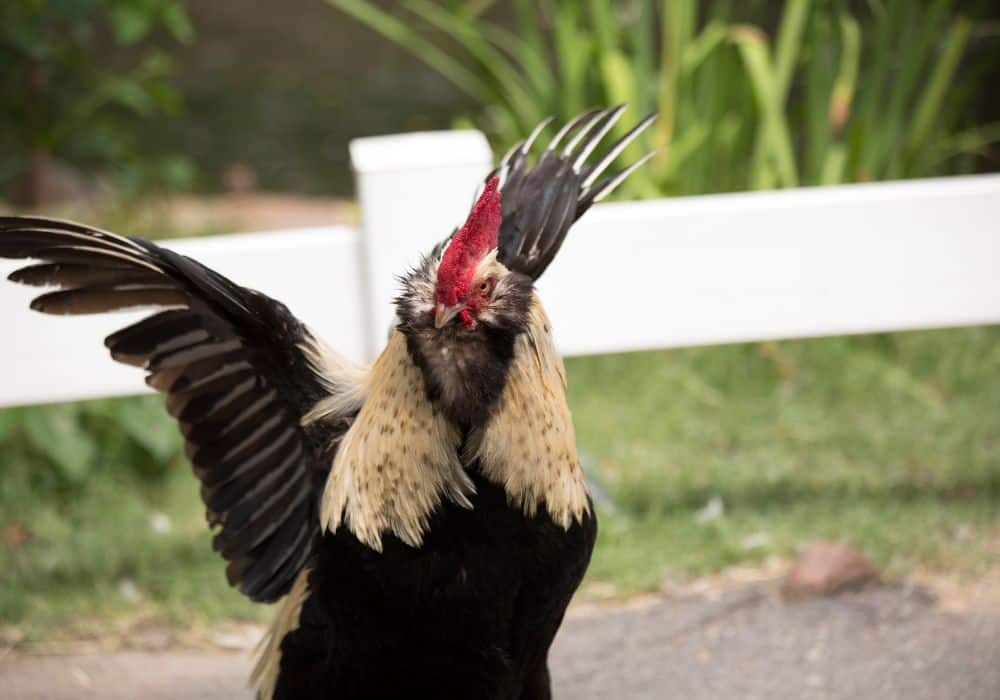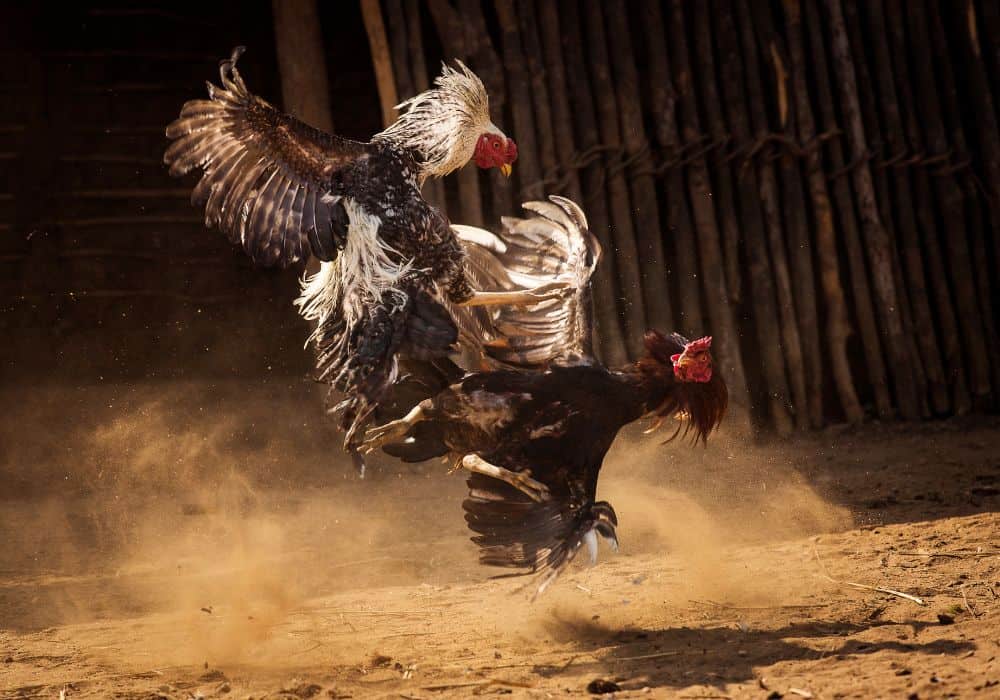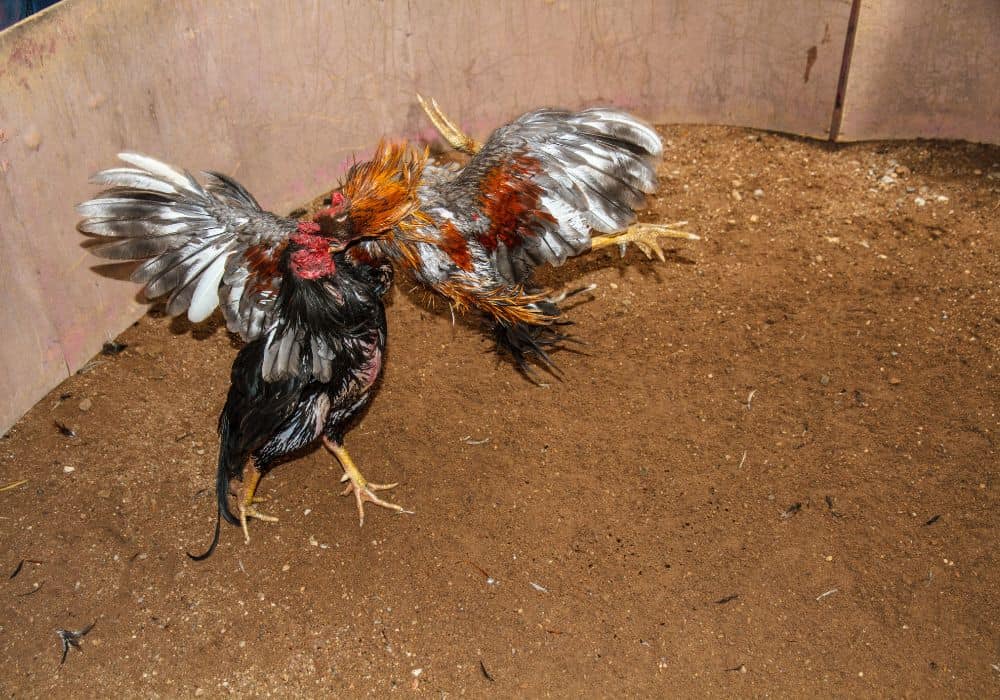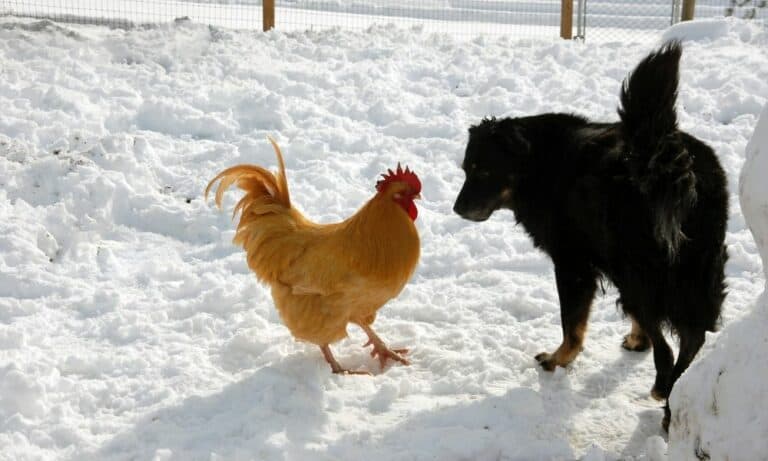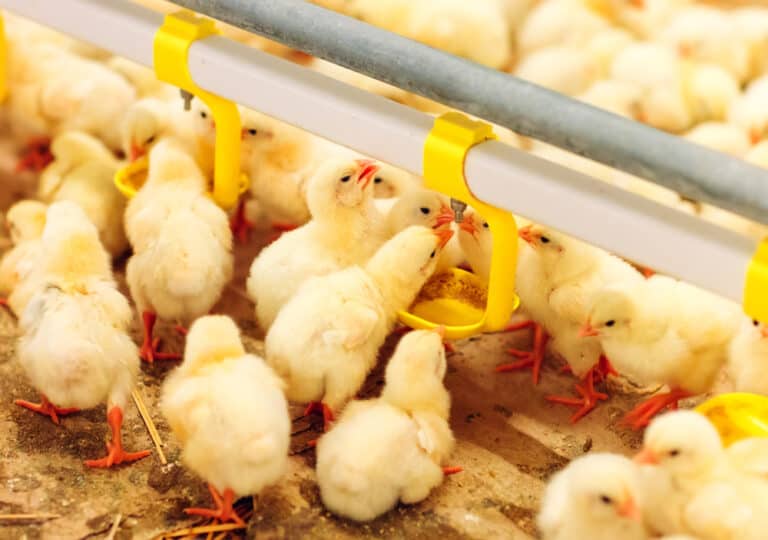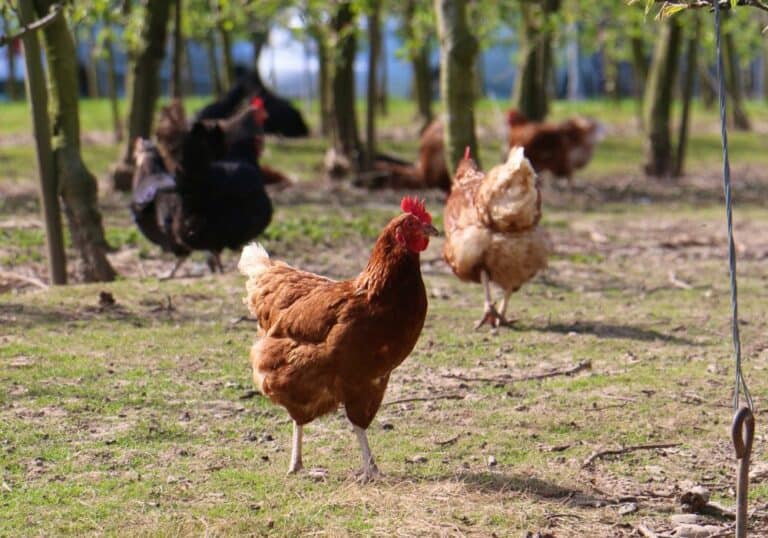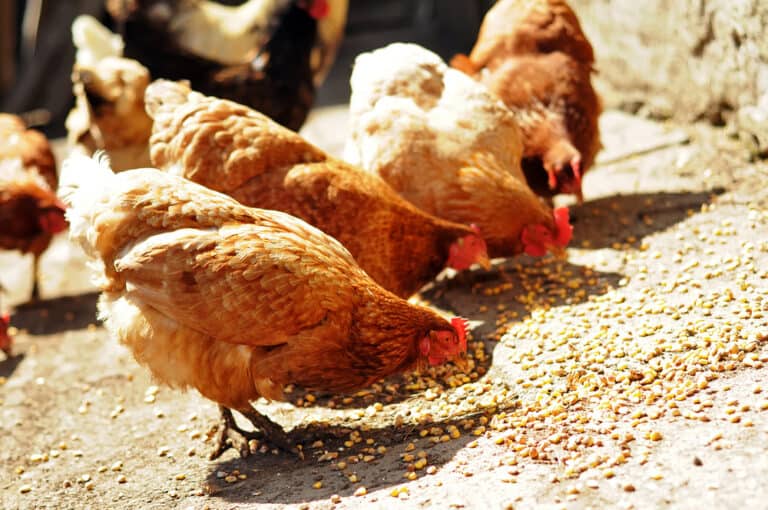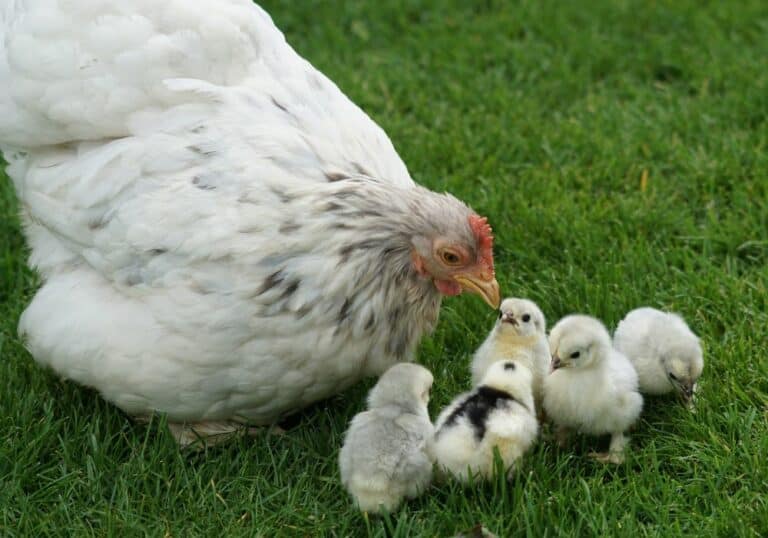Roosters have a reputation for being unforgiving bodyguards that embody the chicken’s close relationship to the Tyrannosaurus Rex, but this is far from their norm. In reality, roosters are usually only aggressive when needed.
That’s not to say the horror stories you hear about rogue roosters are fabricated. Their protective nature can sometimes kick in at the wrong times and in the wrong capacity, making it difficult for their caretakers to tend to the flock.
In this post, we explain how to recognize signs of aggression in roosters and explain where this instinct comes from. We also provide several tips for curbing aggressive rooster behavior, allowing you to gain more control of your flock.
Recognizing Rooster Aggression
Aggression doesn’t usually pop up in roosters until they go through puberty, usually around 4 months (but can be sooner or later depending on the breed). This is when centuries of instincts start to kick in, encouraging the birds to act on behaviors that once protected their flocks in the wild.
Some less obvious signs of rooster aggression include:
- Lowering and/or their head and hopping (dancing)
- Staring you down
- Chasing after your heels
- Flapping their wings for no apparent reason
- Trying to appear larger
- Hackles standing on end
- Stomping their feet
These behaviors are what usually precede the actual attack by a rooster, and they’re your earliest signs that you need to intervene and assert yourself in the pecking order.
The Different Ways of Roosters Attack
https://www.youtube.com/watch?v=scKb9xUjoBw
It doesn’t take long for these preliminary signs of dominance to evolve into a full-blown rooster attack, although they may attack in a number of ways.
Flogging is one of the most common types of attacks, referring to a rooster flying at its opponent and trying to beat them down with his wings. That might not sound like much, but roosters have strong wing bones that will bruise if they hit the right spot.
On top of this, the rooster will try to utilize the sharp spurs on the back of his ankles to do some damage.
Attacks that involve spurring utilize these natural weapons the roosters are armed with. While small, the sickle-like spurs can easily puncture soft skin and do plenty of damage. They’re much more dangerous than the regular talons of a chicken that many already fear.
Pecking is probably what you already picture when you think of a rooster attack. While they have nothing on hawks, roosters are armed with hard beaks that taper to a point. A well-placed peck can easily bruise or draw blood, and it’s often the last step of the rooster’s plan of attack.
Roosters use pecking to finalize any spats they’ve had, either by forcing their opponent into submission or leaving their signature on the fight. A rooster pecking at you is saying he sees you below him in the pecking order, and it’s a sign that you need to assert your role at the top.
The Root of Rooster Aggression
As already stated, aggressive behaviors serve a purpose. Chickens were not always domesticated, and they started off as flocks in the wild that needed to use what little smarts and weapons they had to stay alive.
This resulted in roosters, who have higher levels of aggression-linked hormones and more severe natural weapons, taking up a role as protectors of the flock. They learned to respond quickly and unforgivingly to threats, not giving predators the chance to get the upper hand.
Strong protectors were the desirable trait, and males who protected well were more attractive to the hens and more likely to pass along their genes. They needed to assert their dominance to keep the flock under their protection, and the genes linked to rooster aggression were solidified through these needs.
Rooster aggression is still useful in domestic situations, so it’s not something we need to breed out completely. Instead, we must understand how flock hierarchy works, how to orient ourselves within it, and how to control rooster aggression to ensure our roosters can do their job correctly without compromising the safety of others.
Flock Hierarchy
Both hens and roosters will fight each other to establish their position in the flock, a position that dictates:
- When they can eat (or who they eat before and after)
- How much they can eat
- Which hens they can mate with
- Where they sleep and patrol
Most roosters want to be at the top of this pyramid, giving them access to the most attractive hens, the most amount of food, and the best areas to roost. Not everyone wants to be at the top, and not everyone has a chance at it, but there may be disputes between like-minded roosters who perceive the other as a threat.
It can be difficult for some of them to factor you into the flock, and they may see you as a threat to flock stability as you come and go with food and try to direct the flock members.
This is why it’s so important to understand how to deal with rooster aggression. If they decide you’re acting higher than your station, they will act out and try to put you in your place. As long as you respond appropriately, you should be able to assert your position and get your rooster to channel his testosterone into more useful endeavors.
Factors that Make Roosters More Aggressive
Instinct isn’t the only thing that influences rooster aggression, although it sets the baseline. Other factors that can make them more or less aggressive include:
- Your rooster’s breed
- The hen-to-rooster ratio in your flock
- The diet or your rooster
- How entertained your birds are
- Particular triggers
- The socialization of your roosters
Most of these variables, like choosing a breed based on its aggression, are under your control. Others, like the triggers a specific rooster may have, require understanding and navigation on your part.
Chicken Breed
Breeds with a reputation for overly-aggressive roosters include:
- Shamo
- Old English Game
- Oriental Game
- Modern Game
- American Game
- Cornish Indian Game
- Malay
- Sumatra
- Aseel
These breeds have less human-intervention in their development, and they’re more closely related to jungle fowl than backyard breeds popular today. They are the ones that were used in cock fighting as early as 500 B.C., and they’ve remained after the bans on the sports that only started up in the 1900s.
Hen to Rooster Ratio
If there are too many roosters in a flock, they will need to fight more often to determine who has access to certain females. To minimize this, it’s suggested you only keep 1 rooster per 8 to 12 hens.
This rule becomes more relaxed the larger your flock is, and it’s flexible depending on the breed of chickens you have.
It’s also important to have enough space for each bird. This means a minimum of 4 square feet per chicken in the coop and 10 square feet per bird in the run.
Diet
Like humans, a poor diet can lead to cranky roosters. They should have a solid baseline feed for nutrition and plenty of fresh foods on the side. Allowing your flock to free range can help satiate those instincts while keeping their bellies full, curbing some of the aggression.
Chicken mash, for whatever reason, seems to reduce aggressive behavior in chickens. Adding a tablespoon of salt to their water every third morning, then replacing it with fresh water later in the day, can also ensure they have the proper nutrients for balanced behavior.
Boredom
We aren’t at our best behavior when we’re bored, and roosters are the same way. When they’re stuck in a small, boring run with little entertainment, they will eventually turn to picking on each other and even you.
If possible, make sure you allow your flock plenty of room to roam freely. If they’re stuck in a run, make sure they have plenty of areas to roost and provide enrichment through food puzzles.
Another easy way to enrich your chickens’ lives is by offering live mealworms or other insects for them to pursue or scratch at.
Certain Triggers
Roosters may perceive everyday items as a threat. Some of the most common examples include:
- Floppy boots
- A swinging bucket
- Loose clothing (such as robes)
Instead of understanding that these are mundane items, they may dig into their protective instincts and attack the foreign object. Make sure you don’t bring in anything that seems to trigger your roosters.
Socialization
Roosters that are handled frequently in their youth have a better chance of controlling their instincts as adults. It’s important to get in as much socialization as possible before their hormones roll in around 16 weeks.
Keep in mind that these efforts cannot stop as soon as they hit puberty. In fact, your roosters will probably have a setback around this time. You will need to continue to spend time with them, even if it’s just sitting nearby and reading a book so they can get used to your presence.
Protecting Hens from Aggressive Mating
Sometimes what we see as unwarranted aggression is simply an overly-enthusiastic courting session. Roosters will peck at hens, waiting until they squat to signal they’re ready to be mounted.
At this point the rooster will stand on her back, hold her neck feathers down with his beak, and then steady himself on top. If he favors a small number of hens, they can develop bald patches along their backs, top of their wings, and the back of their heads.
Hen saddles will help if this becomes a problem, but if you notice a rooster consistently drawing blood or distressing his hens you must make a more serious stand. Clipping their spurs will minimize accidental injury, while the actual aggression may escalate enough to merit rooster jail.
How to Curb Aggressive Roosters
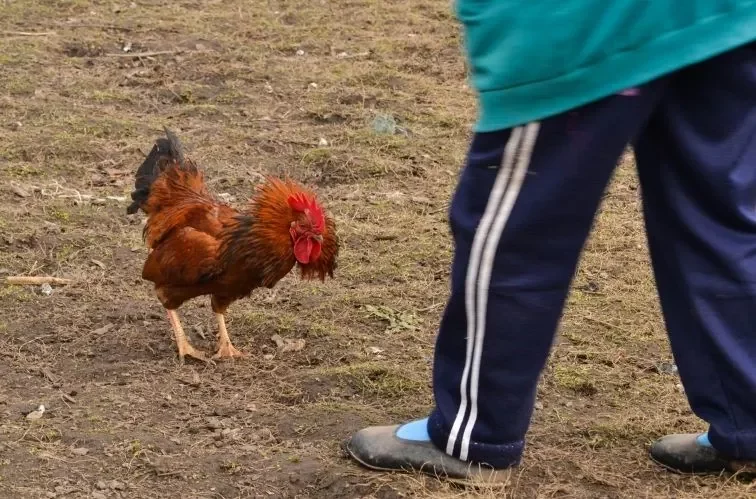
The way that you carry yourself has the most weight in curbing aggressive rooster behavior. You must establish a confident foundation, then respond with tactics like:
- Walking through him
- Donning protective gear
- Bribing the rooster with treats
- Arming yourself with water
- Performing a submission hold
If these don’t work, you may need to separate your rooster temporarily or permanently. The most severe cases require plenty of introspection.
1. Move With Confidence and Awareness
Carrying yourself high (both literally and figuratively) is the best way to respond to an aggressive rooster.
You need to show the rooster that you aren’t scared of him and that you won’t give him an inch of control over you. Make sure you don’t back down to any challenges he sends your way.
This doesn’t mean you need to respond with aggression. Something as simple as walking in with a broom to gently push him out of the way can allow you to continue on without batting an eye.
It’s also incredibly important you keep your head up and do not bend over at any point. Rooster attacks can hurt, but they’re unlikely to do severe damage unless they can get at the soft tissue around your upper body with their sharp spurs.
Keep an eye on your rooster as you complete chores around the yard or the run. If you can interrupt what they think is a surprise attack, you will maintain the upper hand.
2. Walk Through Him
Chances are you will need to learn to walk “through” your rooster to help him learn your position at the top of the pecking order.
Envision yourself taking steps forward while staring him down until he backs up and looks at the ground. If he reacts in kind by rushing at you, be ready to respond by spreading your arms, making yourself large, and continuing forward anyway.
This is easier said than done if you’re already scared of your rooster, and you may need to wait until you follow some other steps (like donning armor) before you feel comfortable making this challenge, but it’s the easiest and most effective way to curb the behavior.
3. Wear Protective Gear and Carry a Shield
While this won’t stop the attack or encourage your rooster to calm down, it can give you the confidence needed to assert your position.
Consider wearing protective clothing or carrying a shield to ward off any attacks. Some examples include:
- Long, thick sleeves
- Thick denim pants
- Gloves
- Protective eyewear
A shield can be something as simple as a broom or a strong stick; whatever you need to have the power to push the rooster away.
4. Bribe Them With Treats
Trying to befriend your rooster is not the same as showing weakness, and acting with kindness is often more effective than responding with your own aggression.
Roosters seem to have a maximum of two brain cells on call, and you can scatter them by tossing feed as you walk into the yard. Unless your chicken has made it his life’s mission to get rid of you, this will often derail the entire attack and earn you brownie points as an ally.
5. Perform a Submission Hold
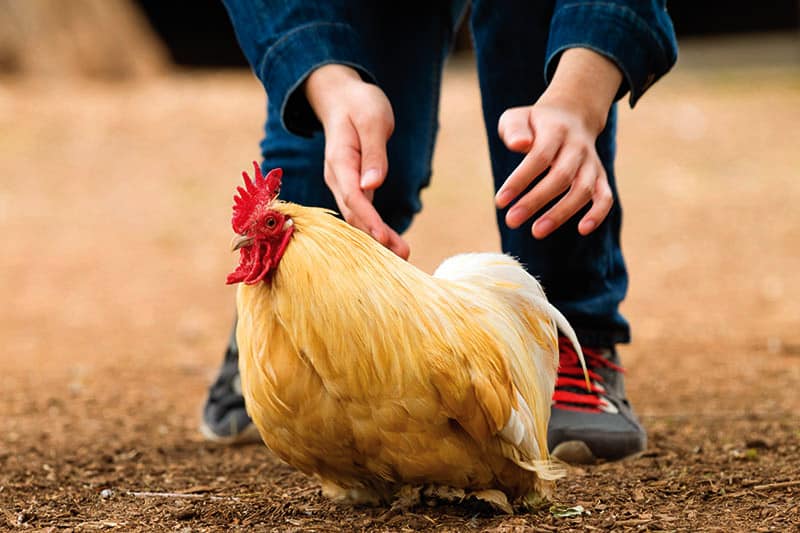
While roosters do damage in a fight, they’re not usually fighting to kill. Instead, the dispute ends until either party gives up. If this doesn’t happen naturally, the stronger bird will pin the other down and force them to forfeit.
You can mimic this behavior to communicate on their level, although we recommend it only after trying less hands-on methods.
To do this:
- Grab hold of the rooster and gently pin him to the ground
- Fit the back of his neck between your middle and index fingers, staking the middle knuckles into the ground to hold him there
- Hold firm while he struggles, taking care not to injure the bird
Struggling is normal, but it’s important to maintain your stance and wait him out. Expect to perform this move a few times before realization finally sinks in.
6. Arm Yourself with Water
If the treats aren’t working, you may need to arm yourself with something less harmful. A spray bottle is lightweight, easily hooks on a belt, and usually effective in disarming your rooster’s aggression.
You want one with a decently powered spray, and you shouldn’t count on complete success with this method. In most cases, the sudden blast of water scrambles their thought processes.
Some suggest a garden hose or a bucket for more persistent roosters, but we urge against this. Completely soaking the bird is likely to make them sick, and it leaves you responsible for drying them off. Neither situation is ideal.
7. Separate Your Aggressive Rooster
If a rooster continues to be aggressive or he’s causing major injury you need to separate him from the flock.
You can keep a rooster colony on your property entirely separate from your hens. Without the females around, the males have less to fight over and instead settle into their bachelor lifestyle with ease.
If this isn’t possible, consider selling or giving your rooster to another chicken owner in your area. He may do better in a different environment, especially if you can find a larger free range flock that has less hierarchical pressure.
The most severe cases warrant culling the bird humanely to prevent further injury and continuation of his aggressive nature. This is not a decision to be made lightly, and should only occur after all other avenues have been exhausted.
Conclusion
Roosters usually aren’t as aggressive as their reputation makes it seem, but they should carry a healthy amount of aggression to keep the flock safe and maintain their position.
When responding to rooster aggression, remember to:
- Do what you need to enter their realm with complete confidence
- Keep your body upright and off the ground
- Focus on befriending the rooster before asserting your dominance
- Follow through with any actions you take
Are you having issues with an aggressive rooster in your flock? Comment with your issues and we’ll help you settle him down.

